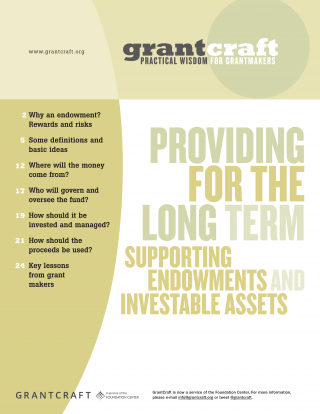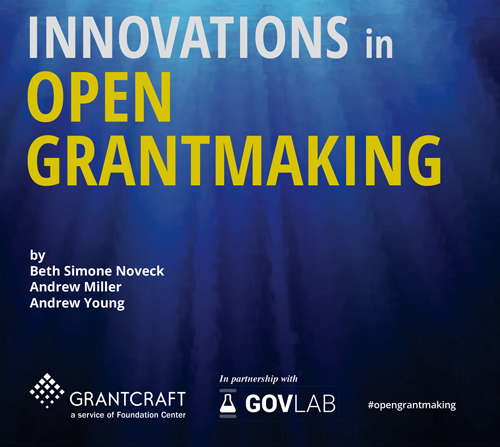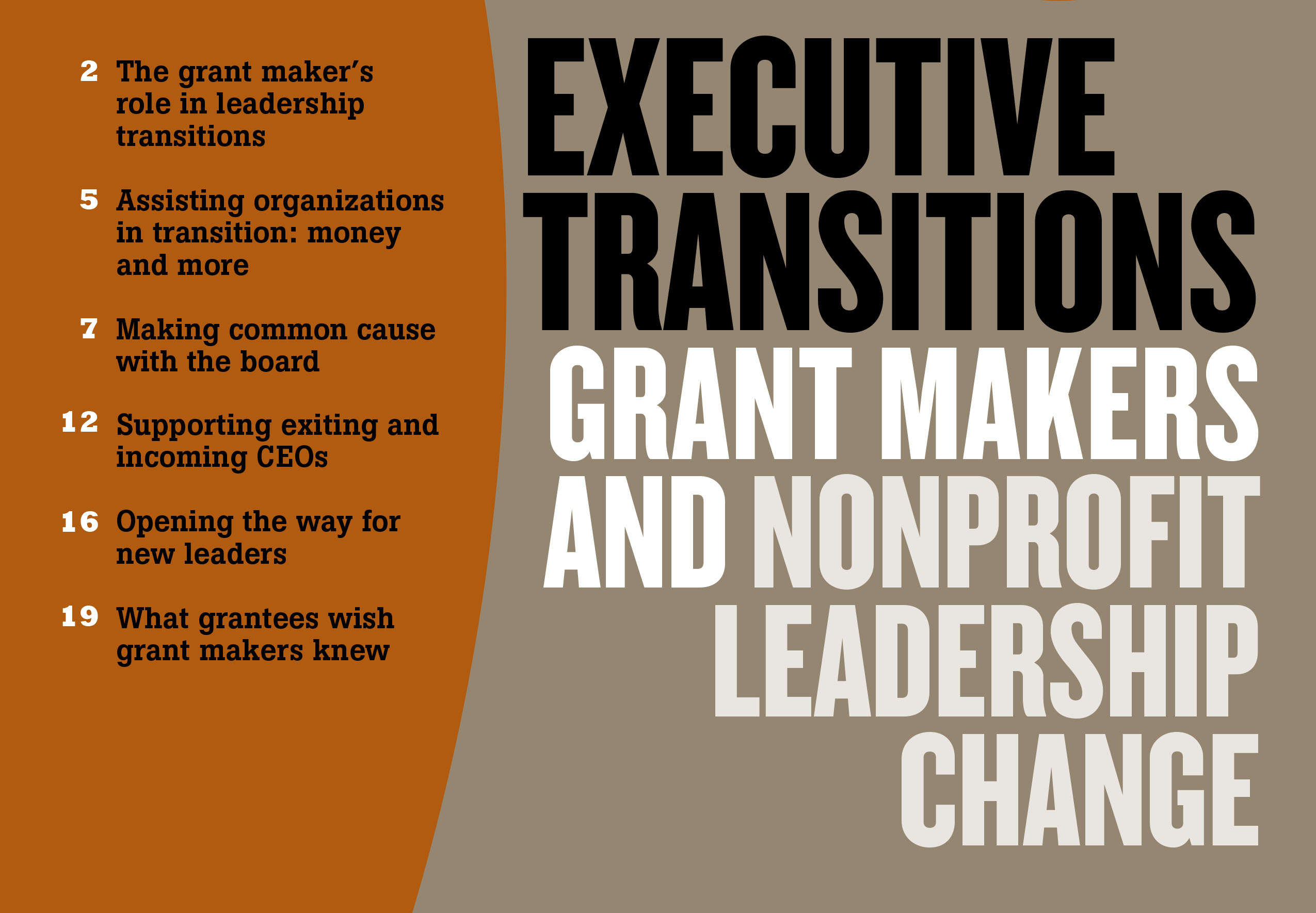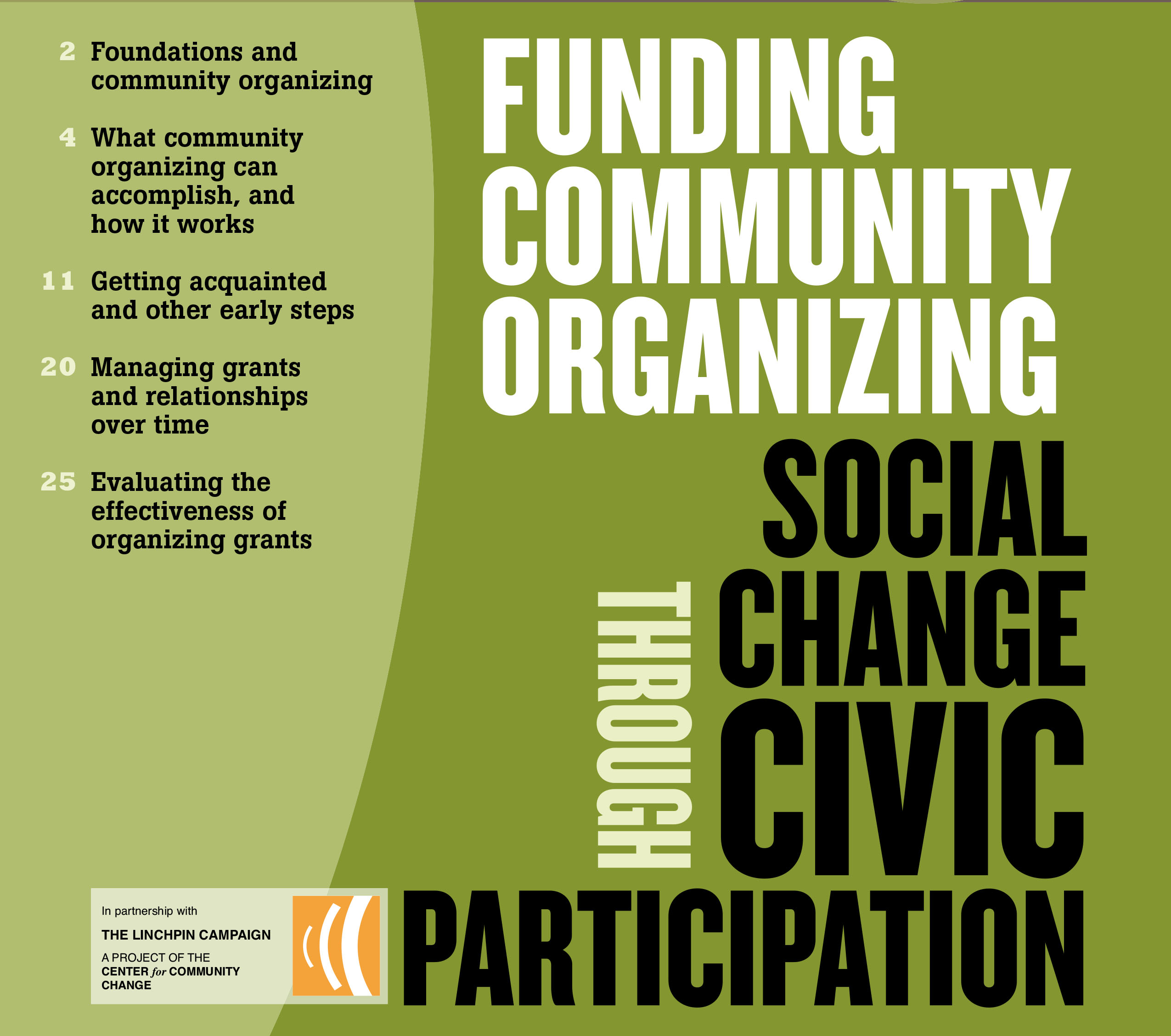Providing for the Long Term Supporting Endowments and Investable Assets
In this guide grantmakers discuss the opportunities and pitfalls of supporting endowments and alternatives to endowments. When the goal is to help strong organizations make longer-term programmatic plans and diversify their sources of funding, endowments can be helpful. But they're far from foolproof. This guide offers some thoughts on how to avoid the most common mistakes and get the most from endowment grantmaking.
Highlights
- Understanding the rewards and risks involved
- Deciding if a grantee is ready
- Figuring out how large an endowment is need
- Determining how it will be managed
What's in the Guide?
- Why an Endowment? Rewards and Risks: What are endowments for? What can they accomplish? And what issues can be expected to arise along the way? This chapter lists a few of the opportunities and challenges that come with making endowment grants.
- First, Some Definitions and Basic Ideas: Endowments and other related kinds of grants help to create an investable fund that generates recurring income for a grantee. There are many ways to approach such funds, and several issues to consider before setting off on this course. This section provides a few general concepts to start the discussion.
- Does an Endowment Make Sense? Is a particular grantee ready for an endowment? And if so, how can the grant maker help to ensure that an endowment grant has the best possible effect? Here, grant makers offer some guidance on how to recognize the right moment for endowment grants, and how to explore the challenges in advance with grantees.
- How Big an Endowment? It's easy to underestimate the amount of money needed for an effective endowment. This section explores some of the elementary calculations, and shows how different assumptions can yield very different results.
- Where Will the Money Come From? Sound planning is one part of creating an effective endowment, but the more obvious part is raising the money. Because of the large amount of capital needed for an endowment, it is wise to consider how an endowment campaign might affect the organization's other fundraising obligations. Here, grant makers offer some experiences and reflections.
- Who Will Govern and Oversee the Fund? A grantee's leadership usually needs preparation, professional guidance, and some new structures and procedures in order to manage an endowment responsibly. This section offers some ideas and examples.
- How Should the Money Be Invested and Managed? Professional advice and fund management are essential, but they're no substitute for a careful grantee and attentive grant maker. Here, grant makers share experiences on ways to set appropriate rules for managing the fund, how to select the right financial advisers and fund managers, and generally, how to help grantees get the most benefit from the endowment.
- How Should the Proceeds Be Used? Depending on the size and nature of the fund, it can make sense to set limits on how the proceeds will be used, how much will be reinvested, and how (or whether) the rules might be changed down the road. This section suggests some approaches to working through these issues with grantees.

Categories
Content type
-
Link to Funding Community Organizing
Definition: What is an Endowment?
Endowments and endowment-like actions typically create or support a long-term financial asset of an organization — a fund that is intended not primarily to be spent, but to be invested.
Read more -
Link to Funding Community Organizing
Why an Endowment? Risks + Rewards
Contributing to an endowment, or to some similar kind of long-term investment fund, can accomplish things that other kinds of support can’t.
Read more -
Link to Funding Community Organizing
When is an Endowment Called for?
An endowment usually represents a turning point — and frequently a great advance — in an organization’s life: Endowments bestow an aura of permanence on an organization, or at least on some aspect of its work.
Read more -
Link to Funding Community Organizing
General Definitions and Terms Endowments
- Endowment grants — which provide some (or in rarer cases, all) of the capital for an organization’s permanent investment portfolio.
-
Link to Funding Community Organizing
Acknowledging the Complexity
Both grantors and grantees tend to pay insufficient attention to the risks and complexities of pursuing an endowment strategy.
Read more -
Link to Funding Community Organizing
Does an Endowment Make Sense?
- Overall Management Review -“This type of review, usually conducted by an outside consultant or firm, develops a clear picture of [an organization’s] strengths and weaknesses.
-
Link to Funding Community Organizing
10 Readiness Factors Is an Organization Ready for an Endowment?
- Outstanding performance, including a track record of adapting to changing needs in its field over time
- Strong leadership and experienced management
-
Link to Funding Community Organizing
An Endowment Like Grant Vs. A Regular Endowment
One grantmaker considered several endowment options before choosing to make a working-capital reserve grant. The grantee needed a source of stable income and wanted an endowment, but a close look at reality led to another choice.
Read more -
Link to Funding Community Organizing
Where will Endowment Money Come From?
Among other things, building an endowment can easily get in the way of other fundraising...
Read more -
Link to Funding Community Organizing
Alternatives to Endowments
Sometimes better fundraising is the solution, not an endowment. Providing an endowment is one way to help a grantee raise its annual income — but it’s a costly and complicated way of reaching that goal.
Read more
In this guide grantmakers discuss the opportunities and pitfalls of supporting endowments and alternatives to endowments. When the goal is to help strong organizations make longer-term programmatic plans and diversify their sources of funding, endowments can be helpful. But they're far from foolproof. This guide offers some thoughts on how to avoid the most common mistakes and get the most from endowment grantmaking.
Highlights
- Understanding the rewards and risks involved
- Deciding if a grantee is ready
- Figuring out how large an endowment is need
- Determining how it will be managed
What's in the Guide?
- Why an Endowment? Rewards and Risks: What are endowments for? What can they accomplish? And what issues can be expected to arise along the way? This chapter lists a few of the opportunities and challenges that come with making endowment grants.
- First, Some Definitions and Basic Ideas: Endowments and other related kinds of grants help to create an investable fund that generates recurring income for a grantee. There are many ways to approach such funds, and several issues to consider before setting off on this course. This section provides a few general concepts to start the discussion.
- Does an Endowment Make Sense? Is a particular grantee ready for an endowment? And if so, how can the grant maker help to ensure that an endowment grant has the best possible effect? Here, grant makers offer some guidance on how to recognize the right moment for endowment grants, and how to explore the challenges in advance with grantees.
- How Big an Endowment? It's easy to underestimate the amount of money needed for an effective endowment. This section explores some of the elementary calculations, and shows how different assumptions can yield very different results.
- Where Will the Money Come From? Sound planning is one part of creating an effective endowment, but the more obvious part is raising the money. Because of the large amount of capital needed for an endowment, it is wise to consider how an endowment campaign might affect the organization's other fundraising obligations. Here, grant makers offer some experiences and reflections.
- Who Will Govern and Oversee the Fund? A grantee's leadership usually needs preparation, professional guidance, and some new structures and procedures in order to manage an endowment responsibly. This section offers some ideas and examples.
- How Should the Money Be Invested and Managed? Professional advice and fund management are essential, but they're no substitute for a careful grantee and attentive grant maker. Here, grant makers share experiences on ways to set appropriate rules for managing the fund, how to select the right financial advisers and fund managers, and generally, how to help grantees get the most benefit from the endowment.
- How Should the Proceeds Be Used? Depending on the size and nature of the fund, it can make sense to set limits on how the proceeds will be used, how much will be reinvested, and how (or whether) the rules might be changed down the road. This section suggests some approaches to working through these issues with grantees.








